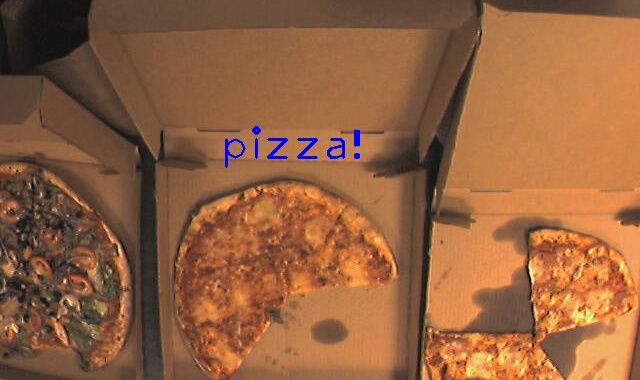 I want to share a small piece of code to do Laplacian Blending using OpenCV. It’s one of the most basic and canonical methods of image blending, and is a must exercise for any computer graphics student.
I want to share a small piece of code to do Laplacian Blending using OpenCV. It’s one of the most basic and canonical methods of image blending, and is a must exercise for any computer graphics student.
Tag: opencv


Just wanted to share of some code I’ve been writing.
So I wanted to create a food classifier, for a cool project down in the Media Lab called FoodCam. It’s basically a camera that people put free food under, and they can send an email alert to the entire building to come eat (by pushing a huge button marked “Dinner Bell”). Really a cool thing.
OK let’s get down to business.
Hi,
I wanted to put up a quick note on how to use Kalman Filters in OpenCV 2.2 with the C++ API, because all I could find online was using the old C API. Plus the kalman.cpp example that ships with OpenCV is kind of crappy and really doesn’t explain how to use the Kalman Filter.
I’m no expert on Kalman filters though, this is just a quick hack I got going as a test for a project. It worked, so I’m posting the results.
I found a nice little trick to ease the work with the very noisy depth image the Kinect is giving out. The image is filled with these “blank” values that basically note where the data is unreadable. The secret is to use inpainting to cover these areas and get a cleaner image. And as always, no need to dig deep – OpenCV has it all included.
 Hi
Hi
Just wanted to share a thing I made – a simple 2D hand pose estimator, using a skeleton model fitting. Basically there has been a crap load of work on hand pose estimation, but I was inspired by this ancient work. The problem is setting out to find a good solution, and everything is very hard to understand and implement. In such cases I like to be inspired by a method, and just set out with my own implementation. This way, I understand whats going on, simplify it, and share it with you!
Anyway, let’s get down to business.
Edit (6/5/2014): Also see some of my other work on hand gesture recognition using smart contours and particle filters
 Hi
Hi
Another quicky on how to use Kinect (libfreenect) with OpenCV 2.1. I already saw people do it, but havn’t seen code.
UPDATE (12/29): OpenKinect posted very good C++ code of using libfreenect with OpenCV2.X APIs: here it is. Plus, their git repo now has a very clean C code: here it is.
So here it goes
Hi,
Just wanted to share a bit of code using OpenCV’s camera extrinsic parameters recovery, camera position and rotation – solvePnP (or it’s C counterpart cvFindExtrinsicCameraParams2). I wanted to get a simple planar object surface recovery for augmented reality, but without using any of the AR libraries, rather dig into some OpenCV and OpenGL code.
This can serve as a primer, or tutorial on how to use OpenCV with OpenGL for AR.
Update 2/16/2015: I wrote another post on OpenCV-OpenGL AR, this time using the fine QGLViewer – a very convenient Qt OpenGL widget.
The program is just a straightforward optical flow based tracking, fed manually with four points which are the planar object’s corners, and solving camera-pose every frame. Plain vanilla AR.
Well the whole cpp file is ~350 lines, but there will only be 20 or less interesting lines… Actually much less. Let’s see what’s up
 Hi,
Hi,
I’ll present a quick and simple implementation of image recoloring, in fact more like color transfer between images, using OpenCV in C++ environment. The basis of the algorithm is learning the source color distribution with a GMM using EM, and then applying changes to the target color distribution. It’s fairly easy to implement with OpenCV, as all the “tools” are built in.
I was inspired by Lior Shapira’s work that was presented in Eurographics 09 about image appearance manipulation, and a work about recoloring for the colorblind by Huang et al presented at ICASSP 09. Both works deal with color manipulation using Gaussian Mixture Models.
Update 5/28/2015: Adrien contributed code that works with OpenCV v3! Thanks! https://gist.github.com/adriweb/815c1ac34a0929292db7
Let’s see how it’s done!
 ICP – Iterative closest point, is a very trivial algorithm for matching object templates to noisy data. It’s also super easy to program, so it’s good material for a tutorial. The goal is to take a known set of points (usually defining a curve or object exterior) and register it, as good as possible, to a set of other points, usually a larger and noisy set in which we would like to find the object. The basic algorithm is described very briefly in wikipedia, but there are a ton of papers on the subject.
ICP – Iterative closest point, is a very trivial algorithm for matching object templates to noisy data. It’s also super easy to program, so it’s good material for a tutorial. The goal is to take a known set of points (usually defining a curve or object exterior) and register it, as good as possible, to a set of other points, usually a larger and noisy set in which we would like to find the object. The basic algorithm is described very briefly in wikipedia, but there are a ton of papers on the subject.
I’ll take you through the steps of programming it with OpenCV.
